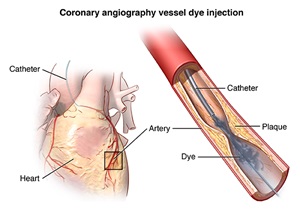Heart Catheterization
A heart catheterization (also called a cardiac cath) is an X-ray exam of the heart and its coronary arteries. It looks at how well the heart is working and helps detect where coronary arteries may be blocked or narrowing.
During the exam, a thin catheter (tube) is inserted in the femoral artery in the groin (or occasionally the brachial artery in the arm or radial artery in the wrist). The catheter is  slowly passed to the heart. Contrast dye is injected to allow the blood vessels to be seen, and X-rays are taken. The exam involves little or no discomfort and lasts one to two hours.
slowly passed to the heart. Contrast dye is injected to allow the blood vessels to be seen, and X-rays are taken. The exam involves little or no discomfort and lasts one to two hours.
If a blockage is found during the catheterization, your physician may be contacted. In some cases, treatment is done during the exam itself. This may include angioplasty and often stent placement. In angioplasty, a catheter with a balloon tip is inserted into the narrow artery. The balloon is slowly inflated to open up the artery. At this time, a small metal coil (stent) may also be inserted to keep the narrow artery open.
A small sample (biopsy) of heart tissue may be obtained during the procedure to be examined later under the microscope for abnormalities.
You will remain awake during the procedure, although a small amount of sedating medication will be given beforehand to ensure that you remain comfortable.
Why have a heart catheterization?
A cardiac catheterization may be performed to assist in the diagnosis of the following heart conditions:
- Atherosclerosis: A gradual clogging of the arteries by fatty materials and other substances in the blood stream
- Cardiomyopathy: An enlargement of the heart due to thickening or weakening of the heart muscle
- Congenital heart disease: Defects in one or more heart structures that occur during fetal development, such as a ventricular septal defect (hole in the wall between the two lower chambers of the heart)
- Congestive heart failure: A condition in which the heart muscle has become too weak to pump blood efficiently, causing fluid buildup (congestion) in the blood vessels and lungs, and edema (swelling) in the feet, ankles and other parts of the body
- Valvular heart disease: Malfunction of one or more of the heart valves that can affect blood flow within the heart
A cardiac catheterization may also be performed if you have recently had an episode(s) of one or more of these symptoms:
- Chest pain or angina
- Shortness of breath
- Dizziness
- Fatigue
You may also undergo a cath procedure to evaluate your myocardial perfusion (blood flow to the heart muscle) if you have chest pain or angina after a heart attack, heart bypass surgery or coronary angioplasty.
Related Resources
- For more information about heart catheterization, including what to expect before, during and after the test, read this important article.
- Cardiac Catheterization Brochure: For further information about what to expect before, during and after a cardiac catheterization. English | Russian | Spanish
